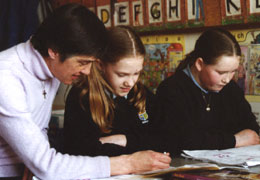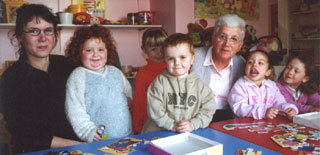New Ross
In 1853 the Parish Priest of New Ross, Fr. James Walsh, invited Sisters from Wexford to make a foundation in the town. New Ross had also suffered in the aftermath of the 1798 Rebellion and again as a result of the famine. However financial assistance from a wealthy businessman by the name of Molloy enabled the Sisters to establish the foundation. This first convent was in Priory Street, but it was too small to accommodate a school. The primary work of the Sisters at that time consisted in visitation of the many sick of the area.
 Mary Madigan, a resource teacher in the primary school, with some of her pupils
Mary Madigan, a resource teacher in the primary school, with some of her pupils
Then in 1856 a bigger house – the former home of a Mr. Tottenham who was the MP for New Ross – became available. The Sisters rented this house for the next one hundred and eleven years. There they opened a Benefit School for those who could pay and later a school for those unable to pay fees. Then in 1862, this latter school – the Poor School as it was called – became part of the recently established National School System of Education.
Until 1857 the convent in New Ross remained a branch house of the Wexford foundation. Then it became autonomous, with Aloysius Sinnott being appointed its first Superior. Another Professed Sister, Francis Farrell along with two Novices – Borgia Crolly and Stanislaus Cheasty were also assigned to the town. Both made their Profession on 25th November, 1857.
The Sisters still reside in New Ross today and are engaged in education and pastoral work.
Carrick-on-Suir
In the early 1870’s the parish priest of Carrick-on-Suir made a request to the Superior of Wexford Convent for Sisters to open a school for girls in Carrick. In response, on 9th March, 1874 five Sisters – Borgia Corcoran, Xavier Richards, Patrick Maguire, Baptist Kirby and Mechtilde Lacey – arrived to establish the new foundation. Initially they stayed in temporary accommodation as the house known as the ‘Red House’ was being renovated. They moved to the newly renovated convent in August 1874.
As in so many other towns, the Sisters began to establish schools. Large numbers attended the Intermediate School. A Junior School was also opened later called St. Anne’s Junior School.
Then in 1874 a new building replaced temporary accommodation, which was a National school for those who could not afford to pay fees. This functioned in its own right until 1974, when it was amalgamated with the Presentation School under their management. At that time also the two secondary schools were amalgamated under the management of the Sisters of Mercy.
A House of Mercy was established in 1891 at Deerpark, which is a mile from the town. Seven girls were trained in laundry work. This work was discontinued in Deerpark due to a property dispute and was later relocated in Mill Street. Then a Mr Power, who was the father of one of the Sisters – Sr. Gertrude, donated an extensive site on which a fine building was erected. However, the House of Mercy was closed in 1902, due to severe financial difficulties. The whole establishment was eventually placed under the Department of Technical Education. Grants were then received and the school began to flourish. The building was extended and additional facilities provided. It continued in existence as St. Joseph’s College of Domestic Science until it closed in 1991. The school building was then leased to the Vocational Education Committee.
 Maura Molloy with some of the children in a creche in Springwell, Carrick-on-Suir
Maura Molloy with some of the children in a creche in Springwell, Carrick-on-Suir
At the request of the Poor Law Guardians the Sisters took charge of the Workhouse Hospital in 1879 and in 1886 they took charge of the Workhouse School, which was for girls under fourteen. The workhouse was burned to the ground during the civil war in 1922 by what was known as the irregulars. These were the anti treaty side and were led by Eamon DeVelera, who later became Leader of the country. However to the great pride of the Sisters, ‘DeV’ himself escorted the Sisters to safety from the workhouse to the convent in the Main Street.
Today the Sisters still live in Carrick and are engaged in various pastoral and educational works in the area.


